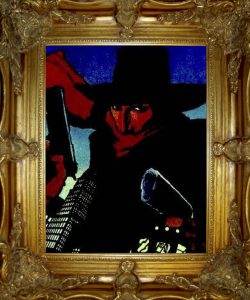 Way back in 1930 the biggest show on the air — the radio air that is — was a show that started with the chilling refrain, “Who knows what evil lurks in the heart of men? The shadow knows . . . ”
Way back in 1930 the biggest show on the air — the radio air that is — was a show that started with the chilling refrain, “Who knows what evil lurks in the heart of men? The shadow knows . . . ”
Secrets are the dark side of our portraits. First, the Dutch Masters created this nuance in oil, and later photographers recreated it on film. What they discovered was that showing less light on one side of the face or subject, brings out depth and dimension. It’s how they created the realism of a three-dimensional image when, as you know, the paintings or film were two-dimensional rectangles. They call it “modeling.” It makes a picture more interesting, less flat.
In writing, characters need shadow too. And for the same reason: to make them more interesting. Only in this case, the shadow must come from within the character, not from external shading. The source of this darkness is usually the secrets a human shares with no one but themselves, the kinds of awful internal things that only self-love can abide. Call it the darker side of our humanity. Since without dark there can be no light, then it follows that there can be no enlightened humanity without the penumbra of our darkest inner thoughts. The literary opportunity here is that these very same secrets could also generate self-loathing.
Characters can be defined not only from what they love, admire, and respect, but also from what they fear, loathe, and hate. The most intimate of these are self-doubt, self-loathing or even self-hate. Often when a character conquers, masters, or gives in to this most personal fault, it becomes the climax of the character’s internal struggle. I believe this makes a character more human, memorable, and ultimately real.
In photography, contrast ratio is defined as how much light is employed against how much dark. In literary characters, how much light they emit is also a ratio between their secrets, baggage and internal weight – against their lighter natures. This is a very essential tool in deep character analysis. That analysis, by the way, is always best done after the character has taken form. In my opinion, these character elements should be discovered as you are writing your story and not pre-engineered into their DNA before you start to write. That way these foibles become more organic to the flow of the story and don’t stick out like — “And now a word from the character building department.”
So, shading a character in prose is akin to utilizing “Rembrandt Lighting” in art, film, or photography. The ten-dollar word for this technique is “chiaroscuro,” which Merriam-Webster defines as: the quality of being veiled or partly in shadow. How many of us live behind a veil or know folks who are hiding some deep dark secret that is bending or shaping their personality. As an author, you may choose to reveal the secret(s) to the reader or not, but as a tool for having the character act and behave in a certain way, knowing this part of your character’s make up will guide you in SHADING or COLORING your character’s actions, reactions, and observations at any point in your story.
As in all things, too heavy a hand, too much obvious contrast, and our work, and our characters, start to look stagey, overdone. But the right balance of contrast and dimension, brought on by the shadow of secrets, will make our character’s inner struggle fit seamlessly into the canvas of the story.
 —Tom Avitabile
—Tom Avitabile
Tom Avitabile is a senior v.p. in advertising, as well as a writer, director, and producer with numerous film and television credits. His recent trilogy of novels chronicle the exploits of Science Advisor to the President “Wild” Bill Hiccock. The first of this series, The Eighth Day, became a Barnes and Noble #1 bestseller. His latest hardcover novel, Give Us This Day, also became a number one best seller.

Tom, I absolutely agree. Everyone makes mistakes and has fears and flaws. That’s what makes us who we are. So as a writer if I’m going to want my characters to be believable and relatable, then by gosh, they’d better have weakness and fears and flaws, and maybe, just maybe they see themselves in need of facing them. Or not. Love THE SHADOW, by the way, one of my favorites. Terrific post, thank you!